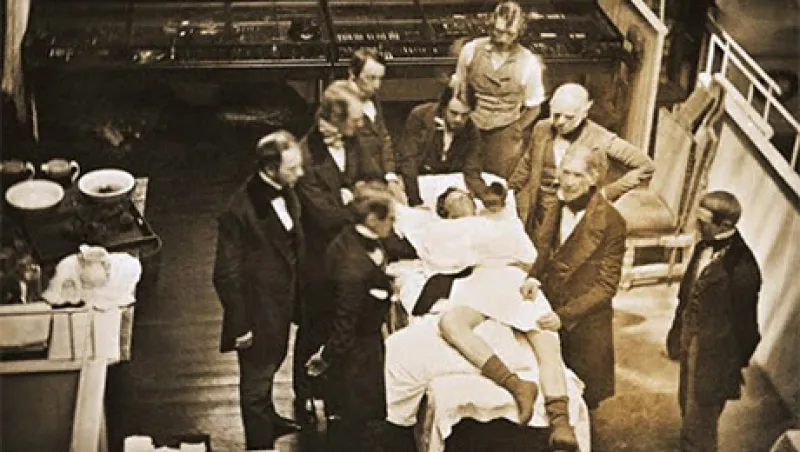In advertisements for ABC’s new drama Forever, Dr. Henry Morgan, New York City’s star medical examiner, is portrayed standing in front of a 19th century Victorian-style surgical theater at the moment before you know someone will need to start mopping the floors from red back to white. Morgan, played by Welsh actor Ioan Gruffudd (best known as Reed Richards in the Fantastic Four movies), has a secret: He has been alive for nearly two centuries — in a Wolverine-meets-House mash-up premise — and therefore was around to see when surgery was not as clean as it is today.
But is surgery today such a “surgical operation” — to use a military term — by any standard other than by contrasting it with the Victorian operating theater? In one of the early Star Trek movies, the crew travels back in time, ends up visiting a 1980s hospital and recoils. To the people of the future, the modern operating room still looks like a torture chamber, the instruments nightmarish and barbaric.
It’s true that fewer reports of innovations in health and medicine hit the headlines than in any other technological field — and for good reason. As a field, medicine is highly regulated, to reduce risk to patients: Research proceeds comparatively slowly and is intensely expensive. Nonetheless, even highly specialized medical fields and techniques have shown fascinating, relatively rapid progress in the past two decades. Laparoscopic surgery uses cameras and tiny instruments inserted into small incisions to perform procedures that might have required chest spreaders before. In the 1980s — which so disgusted Star Trek’s Dr. McCoy — remote-controlled procedures called robotic surgeries first replaced human hands with delicately calibrated steel tools controlled by surgeons standing nearby, not at the operating table.
As we move toward 2020, the next generation of robotic surgery is represented by companies like Sunnyvale, California–based Intuitive Surgical, which specializes in the design and sale of minimally invasive surgical systems. The company has a $17 billion market cap and is highly ranked on Forbes’s list of most innovative companies; it makes most of its revenues from the domestic sale of a system called the da Vinci, a gleaming, insectlike array of robotic arms that sits beside a rolling console for the surgeon and a visualization console that shows every aspect of the operation under way.
The strengths of a da Vinci system are many: It provides a surgeon with three or four arms as opposed to two, and those arms are much more stable and flexible than their flesh-and-blood counterparts. The range of motion of a da Vinci wrist — called an EndoWrist — is far superior to that of a human wrist. Surgeons using a da Vinci can also see what they’re doing much more clearly than they could under standard operating room conditions; its dashboard presents them with visualization in high-definition 3-D at 10x magnification. Surgeons are thus allowed to see inside incisions, scrutinizing and navigating through spaces that, before da Vinci, they could only have glimpsed by making a large incision.
Despite all this promise, there is concern that Intuitive Surgical stock — as well as the MedTech sector as a whole — might nosedive, given the instability the Affordable Care Act has introduced into hospital budgets. And there have been even deeper, industry-level questions concerning the overall costs, benefits and complications associated with robotic surgery. Just this week the Wall Street Journal reported on a Columbia University study that compared robotic surgery to regular laparoscopic surgery and found that the technology costs significantly more and has a higher rate of complications than regular minimally invasive surgery for removing ovaries and ovarian cysts. The article largely misses the point. The early Teslas had nowhere near the cost logic and realized economies of scales achieved by later models and were associated with now well-publicized fires. Though serious at the time, the electric car market has over the long run show itself to be undeterred. All early technologies, almost by definition, can not achieve the economies of scale of incumbent but archaic methods, and beginnings are associated with complications. While these principles are more serious where the domain is medicine and human subjects, regulatory authorities, such as the FDA, exist to measure and balance these risks with the rewards of medical advancement and human betterment.
Other uses of new technologies in medicine, including natural extensions of robotization, are on the horizon. Virtual reality training for surgical procedures has been weighed carefully in the U.S. and abroad, especially for the performance of repeated, routine tasks. The consensus remains that the procedures are too expensive, and that adverse results — patient death and injury and other complications sustained at the hands of inexperienced surgeons — still need to be minimized.
But the promise of achieving that most important phenomenon in all of tech — scale — in a field that has been naturally the hardest in which to achieve it is just too enticing for innovators to pass up. In June the New York Times reported on a surgeon at Duke Medical Center who is using Google Glass to record and stream foot and ankle surgeries to India, where surgical technique lags behind that of the U.S. The use of Google Glass to monitor vital signs and even guide surgeons through complicated procedures is already under study. Whatever might result with Intuitive Surgical and its peer companies, or applications of Google Glass to medicine, the medtech space will be worth paying close attention to in the coming years. The intersection of the largest graying population in human history — the baby boomers — with radical transformations in the economics of medicine, such as ACA, will make demands of efficiency and scale that only technological innovation is prepared to answer.
Get more on technology.






